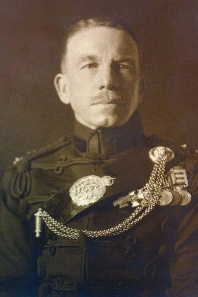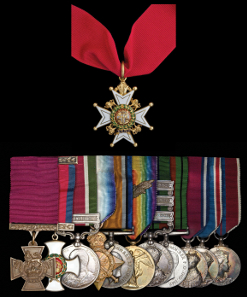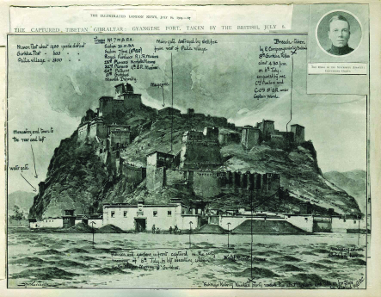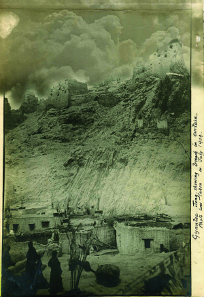01-07-2014 – 01-01-1970
Orders, Medals and Decorations
UK Record for Unique Tibet Victoria Cross Medal Group
The only Victoria Cross awarded for the British campaign in Tibet sold for a UK auction record £408,000* in a sale by specialist auctioneers Morton & Eden in London on Wednesday July 2, 2014. It was purchased by an agent for Lord Ashcroft and will go on permanent public display in the Ashcroft Trust gallery at the Imperial War Museum.
Lt, later Col, John Duncan ‘Jack’ Grant wearing his medals.
The VC, Britain’s highest military decoration awarded for valour “in the face of the enemy”, was awarded to Lieutenant, later Colonel, John Duncan Grant (1890-95), who, with a single Gurkha under his command, stormed a formidable Tibetan fortress perched high above a sheer rock face.
Grant’s unique Tibet Victoria Cross medal group, estimate £200,000-250,000.
The medal was one of a group of 12 to Grant which also included the Distinguished Service Order and the Order of the Bath. It had been expected to realise £200,000-250,000.
Said auctioneer James Morton: “We are absolutely delighted to have achieved this outstanding price for this unique VC. On behalf of the vendor and ourselves, we are equally delighted that it has been purchased by Lord Ashcroft so that it can be placed on permanent public display.”
The sale was watched by representatives of the Ghurka Regiment.
John Grant was born in India and educated at Cheltenham College (1890-95) and Sandhurst. He was commissioned as a 2nd Lieutenant in 1898 and joined the 8th Gurkha Rifles in 1902. The following year, he was part of a force sent to negotiate with the Dalai Lama to prevent Russian encroachment into India through Tibet, the ‘roof of the world’.
However there were barriers on the way to the sacred city of Lhasa, including the strategically located and formidable Gyantse Jong, a fortress 200 miles from Lhasa, likened by some British observers to a landlocked Rock of Gibraltar.
The action to take the jong was seen by many observers, including The Times correspondent Perceval Landon, who filed the following eye witness account on the events of July 6, 1904:
A page from the Illustrated London News of July 16, 1904 showing an annotated view of the attack.
“The rock of Gyantse is so steep that it seemed accessible nowhere except along the main approach which was well defended … It was a fearful climb, and the top of it was crowned by a well-made wall flanked by two projecting bastions… At a little past three, a concentrated fire from all points was ordered to be directed upon the wall at the head of this steep climb. The common shell used by the ten-pounders was now employed with terrific effect, and one could see, second by second, a large ragged hole being torn open at this point. Clouds of dust arose and slowly drifted away to the west in the slight breeze, and whenever a lull in the cannonade allowed a clear sight, the breach was wider by a yard or two.
A July 1904 photo of Gyantse Jong showing the breach made by shelling.
“A constant cataract of stone and brick fell down the face of the rock below, which here was almost sheer for forty feet. It was not shell alone that did this work. Magazine fire was concentrated at the same point, and under this whistling canopy of ball and shell, the Gurkhas were soon seen moving upwards and onwards from the houses at the base of the rock. It was a moment tense with excitement, Lieutenant Grant was in charge of the storming party, and soon the first figures appeared over the belt of houses and trees which hem in the rock on this side. Instantly the fire redoubled, and from three points a converging fire hammered and bit upon the wall above the heads.
“Absolutely confident in the skill of the gunners, the Gurkhas climbed on. Not a Tibetan was seen on the wall above, but through the loop-holes of the bastions a few shots were fired, at what was becoming point blank range, and caused one or two casualties among the little figures clambering up on their hands and knees.
“To those who watched from a distance, it seemed as if more loss was being inflicted when again and again one of the escalading force was knocked backwards by the masses of stone and brick dislodged by our shells. The steepness was so great that a man who slipped almost necessarily carried away the man below him also. But little by little the advance was made, and conspicuous in front of the small company was Grant, with one Sepoy, who was clearly determined to rival his officer in one of the pluckiest pieces of work ever known on the Indian frontier. The men now reached a point fifteen or twenty feet below the level of the breach, and it was no longer safe to allow the cannonade to continue…
“Just at this moment, when the General himself was issuing orders that the fire should cease, the thin high piep of the Ghurka bugler cried again and again from the distant rocks in the four shrill consecutive notes which call for silence, and silence reigned. Then, uncovered by our guns, the last desperate climb was made, and up the higher ridges of an ascent so sheer that it was almost impossible for our men to protect themselves, one or two of these little figures scrambled. They reached at last the crumbling wreckage of the Tibetan wall. Lieutenant Grant and his faithful follower were the first two men over, and the great semi-circle of the watching British force held their breath for a second to see if they would be at once shot down. For the moment it was two men against all the enemy that were in the jong – for the third man slipped and carried away in his fall his immediate successor – and it was patent enough to us all that if the Tibetans had but reserved their fire and waited in the bastions, they might well have picked off, one by one, each man as his head appeared above the breach…”
Grant’s Victoria Cross, the last to be awarded before the Great War, was presented to him by Edward VII at Buckingham Palace on July 24, 1905.
After serving in India and New Zealand, Grant returned to India in August 1914 on the outbreak of the First World War, taking part in the attempt to relieve the Anglo-Indian Force besieged in Mesopotamia at Kut. He also served with the 3/11th in the Third Afghan War where he received his D.S.O. and India General Service Medal with three clasps.
Between 1925 and 1928, he was Assistant Adjutant General, Army H.Q., India and was promoted a full Colonel on 2 September 1926. Coinciding with his retirement, he was awarded the C.B. in the Birthday Honours List of 1929, and in 1934 he was appointed Honorary Colonel of the 10th Gurkha Rifles. During the Second World War Grant served with the Home Guard in London.
He died in a nursing home in Tunbridge Wells in 1967 and is among 10 men from the town who received the Victoria Cross remembered in the Victoria Cross Grove in Dunorlan Park.
Grant’s unique Tibet Victoria Cross medal group with Gyantse Jong in the background, estimate £200,000-250,000.
His medal group comprises: Victoria Cross; The Most Honourable Order of the Bath, Military Division, Companion’s neck badge, in silver-gilt; Distinguished Service Order, George V; Gurkha Rifles); 1914-15 Star; British War Medal; Victory Medal, with emblem for Mention in Despatches; India General Service with clasps for Afghanistan, Mahsud and Waziristan; Tibet 1903-1904 with clasp for Gyantse; Defence Medal; Silver Jubilee Medal; and 1937 and 1953 Coronation Medals.
*The price quoted includes 20 per cent buyer’s premium.
For more information on the auction sale visit the Morton & Eden website.
You can find the online catalogue of this auction here.
none








